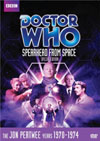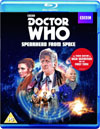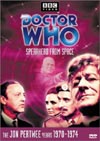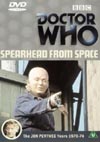Special Edition Standard DVD Extras (NONE of which are on the blu-ray version!) include:
Blu-ray Extras include:
Filmed in ColourColour splashes boldly onto the screen with a new title sequence and new version of the theme song, both of which are extremely satisfying. Further improvement to the graphics might have included a moving background continuing behind Jon Pertwee's face after it solidifies clearly, so that it and the finished title logo might spend more time on screen being legible and recognizable, and less time in flux. The theme song now wisely spends less time on its introductory bars and more time on the signature portions of the melody, portions that often did not get their due when the previous titles faded early to specially prepared opening sequences for individual stories.This is not the first colour Doctor Who production, however. Due to a studio scenery workers strike, the whole story was shot on film on location, giving it a look extremely close to previous Peter Cushing Dalek films. "Spearhead From Space" easily surpasses "Dr. Who and the Daleks" (remake of story no. 2) in quality, but "Daleks' Invasion Earth 2150" (remake of story no. 10) manages to hold together a bit better in my view.
Surrogate Pilot StoryThe Doctor's entrance is not all that it should be. Episode One is full of short snippets of different characters in different locations doing different things, and they are not all linked up as effectively as they could be. Early scenes of the Doctor are the most disjointed of the bunch. I have no complaints about the actual footage, or the basic idea that Robert Holmes and Terrance Dicks came up with in not showing much of the Doctor at first and revealing him very slowly - that's great and, in itself, that idea works. It's the surrounding material, however, that fails to support it. The poor frightened, sweating chap manning the radar raises a question: "I suppose they must have been meteorites, mustn't they?" The camera has moved in on him, indicating how important a question it is. Unless that question is deflected, the next shot will have the aura of trying to answer it cinematically. As originally edited, "Spearhead From Space" answers that question with: "No it wasn't meteorites, it was a police box popping out of nowhere with a man falling out of it." Before any sense can be made of that quick clip, we shift to see lots of an unfamiliar woman cruising through a city in the back seat of a car, not looking very happy despite the accompanying mellow tones on the soundtrack. First time viewers of Doctor Who may justifiably be wondering what the heck this is all about at this point. One quick fix that comes to mind is to first deflect the question from the radar scene, and adapt it properly to what follows. Let the female UNIT officer answer the radar operator with something like "With so many small governments pushing their limited technology into the space race, you never know what's going to fall from the sky next these days." Now the stage is set for the arrival of the TARDIS, a new and wondrous something IN ADDITION to the odd meteorites, with a sense of mystery surrounding it. And don't rush its entrance either. Build it up with some music. Let the materialization take its time; play the model footage at half-speed if necessary. The sound effect is still passable when played in the wrong direction, but unfortunately its cue sounds fumbled, as it hurriedly winds up from zero to normal speed at full volume, instead of fading up its volume like usual. A similar fumble later throws the title music out of sync with the graphics, until there isn't any music left to cover the curiously absent "episode two" caption (now cleaned up for the recent DVD releases). Things like this made the production seem hurried and sloppy.The Doctor's second scene, being covered up and hauled through a hospital on a stretcher while Captain Munro and Dr. Henderson talk about him, is equally out of place in the meteorite investigation that drives episode one's first story beat. The Doctor's first two scenes, however, complement each other beautifully when they are juxtaposed back to back, and fit most logically into the flow of the story when squeezed between the Brigadier's reminisces of who the Doctor was and the interruption of Munro's phone call immediately after. One factor aiding this re-timing of events is that the costly night-shooting Robert Holmes wanted was abandoned, and everything now happens in the day when things can be shuffled less noticeably. A pity that the dialogue wasn't altered to remain consistent with day-shooting as well. At any rate, these are fairly minor points that affect the assessment of the adventure as "pilot story" material more than anything else. Regular and casual viewers familiar with Doctor Who should have little trouble following everything. With the new Doctor being revealed slowly, Brigadier Lethbridge-Stewart is called upon to carry the story for most of the first two episodes, being the only familiar face left on the show even though his character only made two previous guest appearances. Nicholas Courtney does the job superbly; the Brigadier is enormously enjoyable as usual, refreshingly open-minded towards fantastic scientific theories and even arguing in favour of them with Cambridge researchers to boot! Caroline John does a nice job of Liz Shaw, spending most of her time as a foil for the Brigadier or the Doctor, where she is at her best. The slow-revelation of the Doctor works best as the Brigadier becomes intrigued and decides to investigate and take precautionary measures, effectively shifting the story onto this new beat. The Doctor's alien nature is finally given its due in this story, as his double-hearted, alien-blood-type physiology is definitively revealed. Only after the Brigadier gets a good look at the Jon Pertwee version of the Doctor do the rest of the audience, and the Doctor himself, get to see him properly as well. Many of the old Patrick Troughton sneaky and mischievous mannerisms are apparent in this initial performance, and even though Pertwee's tall form is not quite as suited to getting away with them as Troughton's was, they are still a logical and enjoyable continuity link. New Pertwee mannerisms are taking root, and will solidify in the following stories as the actor plays the role even straighter and more seriously. The mutual seeking out of actor and producer as the role of the Doctor was cast seems like an inevitable act of providence. Jon Pertwee is the Doctor, from day one.
Although the Doctor explains all about the TARDIS, including
the fact that it is dimensionally-transcendental and what-not,
a scene or two in the interior is an essential missing element,
probably best placed in episode three close to where he tries to
make his get-away. This story can still work excellently without it,
but it unfortunately doesn't make as great a pilot for the entire
series or the later Pertwee era that way. Even just on its own,
being able to show something always works better cinematically and
leaves a greater impression on the audience than just talking about
it in the dialogue.
Dudley Simpson's music is quite tasteful this time around, using a
partially thematic approach that makes it more memorable than usual.
Most of it is quite effective, and even when it isn't, it's still
interesting listening material.
Some of the more suspenseful scenes seem a little hammy in the
way they were directed, particularly the facial reaction close-ups.
They too often center on the person's line of sight, throwing them
out of joint with the rest of the sequences they are edited into.
The episode endings are not great, but will do.
(The spoilers required to elaborate on this point
can be read here.)
The supporting actors do a fairly good job in this one, although
the performances never really shout for attention. Captain Munro
and Dr. Henderson are superb throughout in giving minimal,
underplayed performances; they and Meg Seeley always appear totally
believable. Hugh Burden is successful in making Channing very weird
and mysterious, and John Woodnutt playing Hibbert and Derek Smee playing
Ransome give great performances when playing straight scenes, but when
they have to be frightened or mad, the directing lets them down a bit,
and they come off looking a little silly.
Martinus does better in directing the action scenes, which work
quite well this time around.
The story manages to conclude on a high and humorous note, as
some of the perks and conditions of the new exile format for the
show are decided and laid out in the final scene. The versions
of the theme music for the credits in this story are unique,
cross-fading to portions of itself that rarely get aired
on any other stories.
Comments on this article are welcome. You may contact the author from this page:
|
|||||||||||||||||||||||||||||||||||||||||















